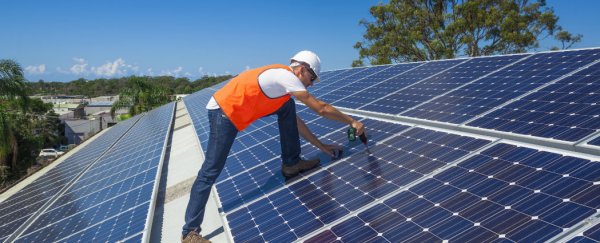Before installing solar panels on your roof, you'll need to know if you're making a good investment, which means knowing how well your new system will perform, and if it's going to save you money on power over the long term. So engineers at the University of New South Wales in Australia have developed a new online tool that can tell consumers just that, making the transition to solar a whole lot easier
The Solar Potential Tool uses 3D spatial data, and allows users to zoom in on a map to locate their roof and to draw a shape, roughly equivalent to the area of the planned system. The tool uses meteorological data to assess the impact of weather, and also works out how shade from nearby buildings and trees will affect the performance of a planned system.
It can also work out how the tilt and orientation of a roof's surface will affect the amount of available sunlight.
Taking all these factors into account, the online tool then estimates the annual electricity generation of a rooftop system, the potential financial savings on your power bill, and the emissions offset your system could enable.
"These new tools are allowing consumers to make informed decisions before they invest in solar," photovoltaic engineer and inventor Anna Bruce, from UNSW Engineering, said in a press release.
The tool, which was developed in partnership with the Australian PV Institute, is part of a larger solar mapping project sponsored by the Australian Renewable Energy Agency (ARENA). The goal is to provide real-time data on the impact rooftop solar is having on electricity demand across the country.
For instance, another ARENA-funded tool in the suite, called PV Postcode, allows users to see how much rooftop capacity has been installed in each suburb since January 2007, and an app called the Live Solar Map uses data from more than 6,000 sites around Australia to display how much energy rooftop solar systems are producing throughout the day in real-time.
The below video shows the rate of rooftop installations across Australia since 2007.
It shows that since July 2011, the country has nearly quadrupled its installed capacity, up from 1000 MW to more than 4,000 MW. In Queensland and South Australia, more than 25 percent of households have solar panels.
"For the first time, we have very good data which demonstrates how solar is contributing to the electricity grid and the impact it is having on reducing loads during peak times," said Bruce.
"More data about distributed energy generation and loads will give electricity operators, the solar industry and government more options for delivering energy services to customers in the future."
Australia needs tools like this to better equip its locals in making the push toward more renewable energy use across the country, especially as other countries ramp up their installed capacity and targets. China, for instance, has made huge strides in wind energy.
By comparison, 2014 wasn't a great year for investment in renewable energy in Australia.
According to Bloomberg New Energy Finance, investment in large-scale projects plummeted 88 percent, to a level not seen since 2002. It saw Australia drop below countries like Honduras and Myanmar, thanks, in large part, to the Federal Government's controversial review of the Renewable Energy Target.
The one saving grace for Australia's clean energy landscape over 2014 was the continued uptake of rooftop solar, as consumers and businesses spent more than $2 billion on new systems.
Hopefully tools like this will help the trend continue.
Love engineering? Find out more about the world-leading research happening at UNSW Engineering.
